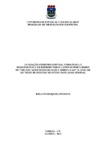Please use this identifier to cite or link to this item:
http://www.alice.cnptia.embrapa.br/alice/handle/doc/1009228| Title: | Avaliação comportamental, fisiológica e hematológica de reprodutores caprinos portadores do Vírus da Artrite Encefalite caprina (CAEV) e análise do Western Blotting no plasma seminal. |
| Authors: | PEIXOTO, R. M.  |
| Affiliation: | Renato Mesquita Peixoto. |
| Date Issued: | 2014 |
| Citation: | 2014. |
| Description: | Resumo: O intuito deste trabalho foi verificar se o vírus da Artrite Encefalite Caprina interfere nos parâmetros clínicos, fisiológicos e hematológicos de reprodutores caprinos com infecção recente ou crônica e também analisar a técnica sorológica de Western Blotting em amostras de plasma seminal na detecção de anticorpos anti-CAEV em comparação às amostras de soro sanguíneos. Foram utilizados 12 reprodutores caprinos de diferentes raças, em bom estado de saúde de acordo com exame clínico geral realizado, os quais foram mantidos durante todo o período experimental (270 dias) em regime intensivo de produção. Os machos tinham de três a quatro anos de idade, e foram selecionados com base no quadro sorológico para o CAEV, sendo seis soropositivos (com infecção natural crônica há mais de 12 meses) e seis soronegativos, obtidos após três testes consecutivos de Western Blottting (WB) e de Nested-PCR (nPCR) no sangue, com intervalo de 30 dias. Os animais foram divididos inicialmente em dois grupos: o grupo de machos com infecção crônica e o grupo de macho pré-infecção. Após 90 dias do início do experimento, os seis machos pré-infecção foram inoculados com a cepa viral CAEV-Cork, título 105,6 TCID50/mL, por via intravenosa. A partir da inoculação viral o grupo pré-infecção passou a ser denominado de grupo de reprodutores com infecção recente e foram acompanhados semanalmente por testes de WB no soro sanguíneo e plasma seminal. Todos os animais inoculados com o CAEV-Cork, soroconverteram após a terceira semana. Os reprodutores de ambos os grupos apresentaram parâmetros fisiológicos e hematológicos dentro dos padrões de normalidade para espécie. Quanto aos parâmetros de comportamento sexual, foi observado que os animais não apresentaram receio à presença do homem em sala de coleta e que a maioria realizou o comportamento de cortejo da fêmea. O tempo de reação não diferiu (p>0,05) entre os grupos e está dentro dos parâmetros normais para a espécie. Entre os animais dos grupos de reprodutores pré-infecção e com infecção crônica para o CAEV que tiveram seu sêmen submetido à avaliação in vitro, através de espermograma, não houve diferença estatística (p>0,05) para os parâmetros de concentração, motilidade e vigor, com exceção apenas do volume do grupo pré-infecção, situação que permaneceu após a realização da infecção. Além disso, estes parâmetros estiveram dentro dos padrões recomendados pelo CBRA (2013). Assim, pode-se concluir que o CAEV não interferiu nos parâmetros fisiológicos e hematológicos de reprodutores caprinos, independente do tempo de infecção do CAEV, mantendo os parâmetros avaliados dentro dos padrões de referência para a espécie. Em adição, a CAE não altera o padrão de comportamento sexual, porém quando os animais apresentam artrite há um quadro de dor e desconforto, afetando o comportamento sexual e comprometendo o bem-estar do reprodutor. Observamos que animais com infecção recente apresentam maior porcentagem de resultados positivos no Western Blotting, tanto no plasma seminal como no soro sanguíneo, do que os animais com infecção crônica, consolidando a importância do diagnóstico precoce do CAEV. Já o diagnóstico de WB em amostras de soro sanguíneo é mais eficiente do que de plasma seminal, independente do tempo de infecção. No entanto, é uma alternativa válida de diagnóstico do CAEV. The aim of this work was to verify if the Caprine Arthritis Encephalitis virus interferes with the clinical, physiological and hematological parameters for breeding with recent or chronic infection and also examine, the technique of Western Blotting in samples of seminal plasma in the detection of anti-CAEV in compared to samples of blood serum. 12 breeding goats of different breeds were used, in good health according to general clinical examination, which were maintained throughout the experimental period (270 days) in intensive system of production. Males of three to four years of age, and were selected based on serological framework for CAEV, six seropositive (chronic natural infection for more than 12 months) and six seronegative obtained after three consecutive tests Western Blotting (WB) and Nested-PCR (nPCR) in the blood, with an interval of 30 days. The animals were divided initially into two groups: the group of males with chronic infection and the group of pre-infection male. 90 days after the beginning of the experiment, six male pre-infection were inoculated with the viral strain CAEV-Cork title TCID50/mL 105.6 intravenously. From the viral inoculation pre-infection group came to be named the group of breeding animals with recent infection and were monitored weekly for WB testing in blood serum and seminal plasma. All animals inoculated with CAEV-Cork, seroconverted after the third week. Breeders of both groups showed physiological and hematological parameters within normal limits for the species. Regarding the parameters of sexual behavior, it was observed that the animals showed no fear to the man in the collection room and realized that the majority held the courtship behavior of the female. The reaction time did not differ (p> 0.05) between groups and is within normal parameters for the species. Among the animals in groups of breeding pre-infection and chronic infection for CAEV which had their semen submitted to in vitro evaluation through semen analysis showed no statistical difference (p>0.05) for the parameters of concentration, motility and force, with the exception only of the volume of pre-infection group, a situation that remained after the completion of the infection. Furthermore, these parameters were within recommended by CBRA (2013) standards. Thus, we can conclude that the CAEV did not interfere with physiological and hematological parameters of breeding, regardless of time of CAEV infection by keeping the parameters evaluated in the reference standards for the species. In addition, the CAE does not alter the pattern of sexual behavior, but when they show arthritis there is a picture of pain and discomfort, affecting sexual behavior and compromising the welfare of the breeder. We observed that animals with recent infection have a higher percentage of positive results in Western Blotting, both in seminal plasma and blood serum than animals with chronic infection, strengthening the importance of early diagnosis of CAEV. Since the diagnosis of WB in blood serum samples is more efficient than seminal plasma, regardless of the time of infection. However, it is a valid alternative for the diagnosis of CAEV. |
| Thesagro: | Caprino Doença animal Infecção Vírus Antígeno Epidemiologia Comportamento sexual Sêmen Anticorpo Diagnóstico |
| NAL Thesaurus: | Goats Lentivirus Immunoblotting Western blotting diagnostic techniques |
| Keywords: | Artrite Encefalite Caprina CAE CAEV Lentivirose Espermograma Serological technique Caprine arthritis encephalit virus Immunological techniques Reproductive behaviour Sexual behaviour |
| Notes: | Dissertação (Mestrado em Zootecnia. Área de Concentração: Reprodução Animal) - Centro de Ciências Agrárias e Biológicas, Universidade Estadual Vale do Acaraú, Sobral. Orientadora: Alice Andrioli Pinheiro; Co-orientador: Raymundo Rizaldo Pinheiro. |
| Type of Material: | Teses |
| Access: | openAccess |
| Appears in Collections: | Tese/dissertação (CNPC)  |
Files in This Item:
| File | Description | Size | Format | |
|---|---|---|---|---|
| CNPC2014Avaliacaocomportamental.pdf | 1.43 MB | Adobe PDF |  View/Open |









